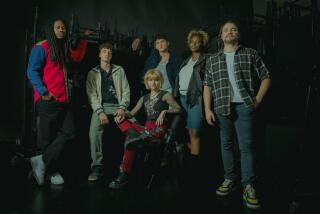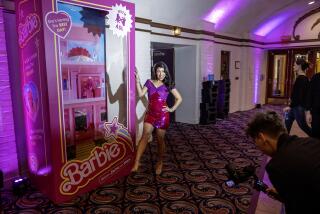Making Music Without a Sound
- Share via
BALTIMORE — As if touched by some extrasensory spirit, Diane Chambers gyrates and gesticulates to the rhythms of Janet Jackson reverberating through the Baltimore Arena.
Rocking and flowing through such slow numbers as “Again” and “Let’s Wait Awhile” and imitating the pseudo-Egyptian hand motions seen in the videos for “If” and “Rhythm Nation,” she becomes a human musical medley.
No, Chambers isn’t a would-be backup dancer vying for Jackson’s attention at a recent concert. She is a music interpreter. Along with three fellow interpreters, Chambers made the event accessible to the handful of deaf concertgoers seated at the front left side of the hall.
For Chambers, performing at a concert isn’t just a matter of signing lyrics--that gets a deaf person no closer to the essence of the show than reading lyrics out loud helps a hearing person understand a song.
Besides making American Sign Language mirror the literal meanings--difficult enough in a separate three-dimensional language with its own idioms and rhymes--she has to express the music.
“It’s an art form for me, because you’re taking the auditory and making it become visual,” she says.
Bilingual Heritage
Chambers, 38, of Catonsville, Md., is a certified sign language interpreter. Since 1985, she has been interpreting everything from Shakespeare plays to medical appointments for the hearing impaired. In 1996, she founded Flying Hands (now Flying Hands and Voices), a Baltimore-based company training and providing interpreters for live concerts and theatrical performances. Her book “Communicating in Sign: Creative Ways to Learn American Sign Language,” which teaches the basics of sign language, was published this fall.
Nonverbal communication had always fascinated Chambers, and she began using it during childhood. Her paternal grandparents, who lived with her, were Greek and spoke very little English. Chambers never learned to speak Greek, but instead communicated with them through gestures and facial expressions.
“I didn’t have deaf parents, but I had this bilingual background, and I grew up respecting other cultures,” she says. “I learned how to respect people who spoke another language.”
Chambers earned her bachelor’s degree in English from Towson University in 1980 and learned sign language at Gallaudet University in Washington from 1982 to 1984.
In 1984, a deaf friend of Chambers’ at the Columbia Campus of the Maryland School for the Deaf asked her to sign a song. Chambers’ friend randomly selected Simon and Garfunkel’s “Bridge Over Troubled Water” out of a stack of old records and set it on the turntable.
“This is like the worst song to interpret, because it’s so abstract,” Chambers recalls, laughing.
She says she stood still, signing the song word for word, much to the dismay of her friend. “She sat there just sort of staring,” Chamber says. “It must have been absolute torture for her.”
That was Chambers’ first, indelible insight that simply signing lyrics is not signing music.
Her friend indicated that Chambers needed to sign in a way that conveyed the emotional and rhythmic context, not just the literal translation.
“That was the very beginning of doing music interpreting. I loved it so much,” Chambers says. “I tell people when I interpret: Show me the music.”
Bringing Out the Feeling
Teresa Clark, a disabilities coordinator, has been using Chambers for six years. “When she interprets, she brings out feeling,” she says. “It’s not just her hands that are moving, it’s her whole body.”
You certainly don’t have to hear to understand Chambers’ sensitivity. She carefully forms her gestures, narrows her eyes and leans in close when describing or trying to understand a concept. Her smile is always on the verge of bursting into a laugh. And when that laugh erupts, her entire being jolts with confidence, joy and energy.
But music interpreting takes even more, Chambers says.
“Not everybody can do it,” she says. “I really, really do believe it’s a gift.”
Chambers subcontracts with eight other interpreters and provides training workshops. She does an average of two concerts a month and about the same number of plays. Currently, Flying Hands is working on national contracts for productions in New York.
Her goal is to be the official interpreter of a touring musician. Stevie Wonder is the first choice of Chambers, who has interpreted for such entertainers as Mary Chapin Carpenter and Etta James.
“That’s what I want to be,” she says. “Interpreter to the stars.”
But it’s not so easy. Five years ago, she put an ad in Billboard and got no responses.
“It’s hard to sell people on the idea of it as an art form,” she says. “I think it’s probably changed now, though. I think the climate’s changed.”
The Americans With Disabilities Act, passed in 1990, with its requirements for interpreters at arts venues, has opened doors for both the deaf and interpreters.
“It’s helped that the fine arts realize there is a whole audience, patrons of the arts they were not reaching,” says Faith Kirk, a member of the Presidents’ Committee on Employment for Citizens with Disabilities.
At the Janet Jackson concert, Dudley Cutshaw, 35, sways in time with the rhythm. “Without the interpreter, I’m lost,” he says. “I wouldn’t be able to follow the show in order.”
He and the other deaf concertgoers pick up Chambers’ cues, while at the same time taking in the color and movement on stage.
Why would a deaf person go to a concert? There are varying degrees of hearing loss, for one thing. And the deaf can feel vibrations. And even for the completely deaf, the glossy spectacle is entertaining.
“It’s so stimulating. You can feel it through your feet. You can hear through your body,” Cutshaw says. “It’s not like just listening to a CD. I don’t get much out of that.”
Chambers says certain types of music, such as jazz, blues and folk, lend themselves more easily to sign.
“I actually did a concert with new-age music, with no words, and I became the music. There were three deaf audience members and they were just thrilled about it,” she says. “I know, it’s very hard to believe. That’s where the challenge and the art form comes in.”
More to Read
The biggest entertainment stories
Get our big stories about Hollywood, film, television, music, arts, culture and more right in your inbox as soon as they publish.
You may occasionally receive promotional content from the Los Angeles Times.










